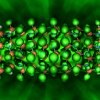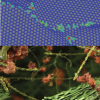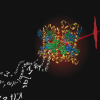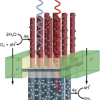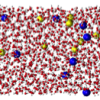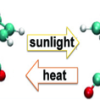Energy Science
Researchers use extreme-scale computing at NERSC to explore the scientific foundations for new and improved energy technologies and to understand how to mitigate the environmental impacts of energy use. This includes using a wide variety of well-established electronic structure methods to study chemical catalysis, nanosystem-based solar devices, fuel cell membranes, and more. Much of this work is enabled by the large cache of optimized chemistry and materials science software that NERSC makes available to its user customers.
Equally as important is the use of NERSC facilities for development of new energy applications that rely on extreme-scale computing, such as the award-winning EMGeo reservoir mapping software for finding oil and gas reservoirs.
Using Computation to Enhance LEDs
Simulations at NERSC have shown that semiconductors made of oft-used materials but with ultra-thin dimensions could lead to dramatically improved LED efficiency. Read More »
Simulations Couple with Experiment to Boost Energy Research
Two recent studies highlight important synergy between theory and experiment and between key DOE research facilities in cutting-edge energy research. In both cases, the researchers are at Oak Ridge National Laboratory (ORNL) and they used ORNL experimental facilities with NERSC supercomputers. Read More »
Artificial Photosynthesis I - Design Principles for Light Harvesting
Several NERSC researchers are trying to fully understand photosynthesis, the process that provides the energy source for essentially all
living things on Earth. The goal is to aid in the design of light-harvesting catalysts that convert water and carbon dioxide into fuels. Read More »
Artificial Photosynthesis II - Joint Center for Artificial Photosynthesis (JCAP) Simulations
JCAP is a DOE funded energy hub. Its goal is to develop systems that absorb light and generate chemical fuels. Material science research is at the heart of JCAP activities. Read More »
EFRC Carbon Capture and Sequestration Activities at NERSC
Transforming the way we generate, supply, transmit, store, and use energy is one of the defining challenges for the 21st century. At its heart, the challenge is a scientific one, and large-scale simulation plays a pivotal role. Several NERSC projects associated with Energy Frontier Research Centers (EFRCs) are involved. Read More »
Finding Hidden Oil and Gas Reserves
America’s economic stability and national security are inextricably tied to having a consistent supply of reasonably priced oil and gas. Researchers Gregory Newman and Michael Commer have used NERSC's Cray supercomputers to develop and advance a new way of creating images of the earth’s crust from multiple types of seismic data. Read More »
Novel Methods for Harvesting Solar Energy
Research in the MIT laboratories of Prof. Jeffrey Grossman involves gaining a deeper understanding of the underlying physics and
chemistry of nano-scale photovoltaic materials and solar thermal fuels. Groundbreaking work has centered on a tantalizing energy storage prospect: molecules that can directly convert sunlight into stored heat in the form of chemical bonds. Read More »






